TOYOTA TACOMA 2011 Owners Manual (in English)
Manufacturer: TOYOTA, Model Year: 2011, Model line: TACOMA, Model: TOYOTA TACOMA 2011Pages: 548, PDF Size: 9.84 MB
Page 101 of 548

101
1-7. Safety information
1
Before driving
*1: The right front passenger on the bench seat.
*
2: The system judges a person of adult size as an adult. When a smaller adult sits in the front passenger seat, the system may rec-
ognize him/her as a child depending on his/her physique and pos-
ture.
*
3: When a larger child who has outgrown a child restraint system sits in the front passenger seat, the system may recognize him/
her as an adult depending on his/her physique or posture.
*
4: Never install a rear-facing child restraint system on the front pas-
senger seat. A forward-facing ch ild restraint system should only
be installed on the front passenger seat when it is unavoidable.
( P. 106)
*
5: In the event the front passenger does not wear a seat belt.
*
6: In case the indicator is not illu minated, consult this manual for
installing the child restra int system properly. (P. 111 )
Page 102 of 548
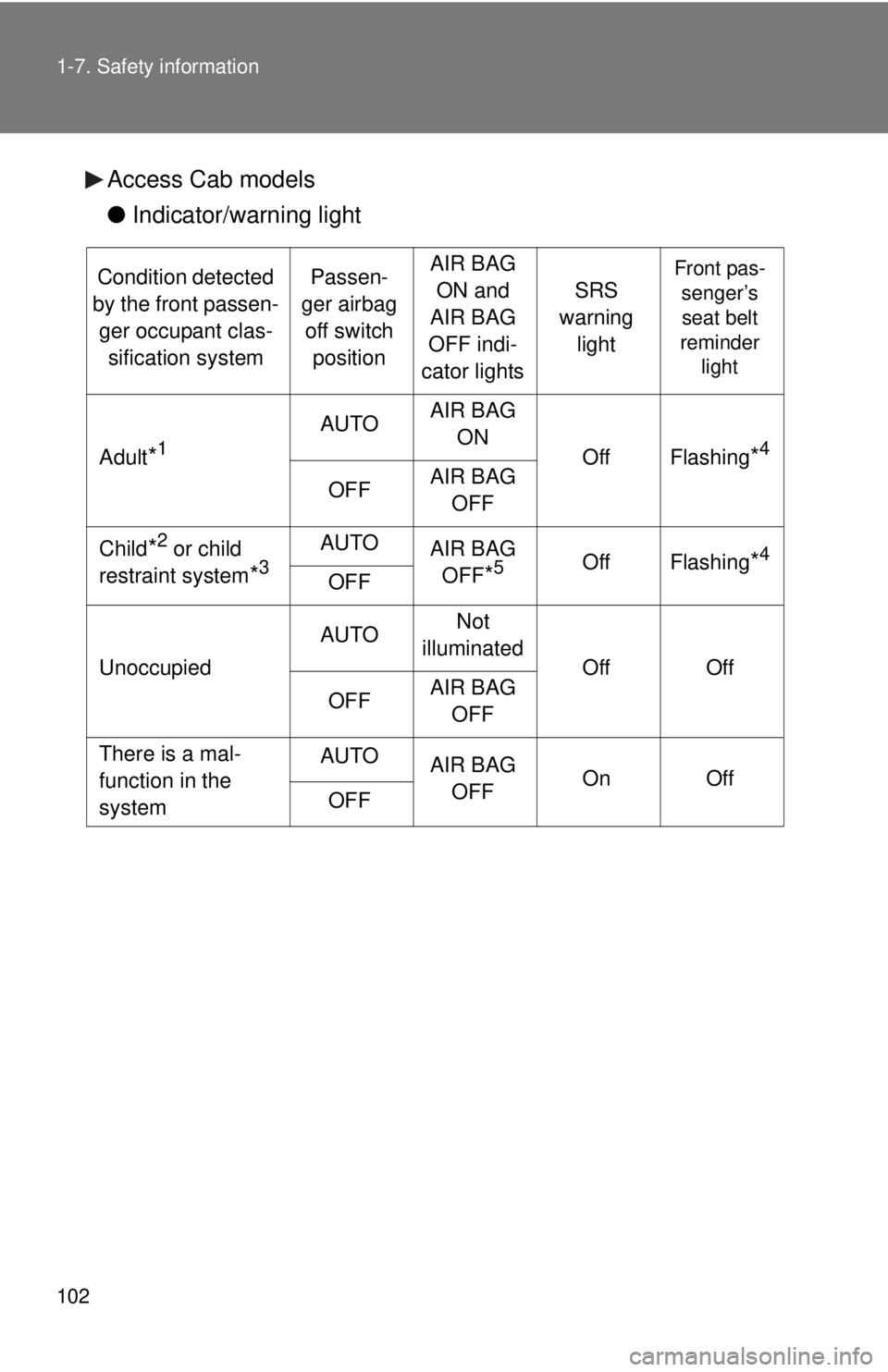
102 1-7. Safety information
Access Cab models
●Indicator/warning light
Condition detected
by the front passen- ger occupant clas- sification systemPassen-
ger airbag off switch positionAIR BAG ON and
AIR BAG
OFF indi-
cator lights
SRS
warning light
Front pas-senger’s
seat belt
reminder light
Adult*1
AUTOAIR BAG
ON
OffFlashing*4
OFFAIR BAG OFF
Child*2 or child
restraint system
*3
AUTOAIR BAG OFF
*5OffFlashing*4
OFF
Unoccupied
AUTONot
illuminated
OffOff
OFFAIR BAG OFF
There is a mal-
function in the
systemAUTOAIR BAG OFFOnOffOFF
Page 103 of 548
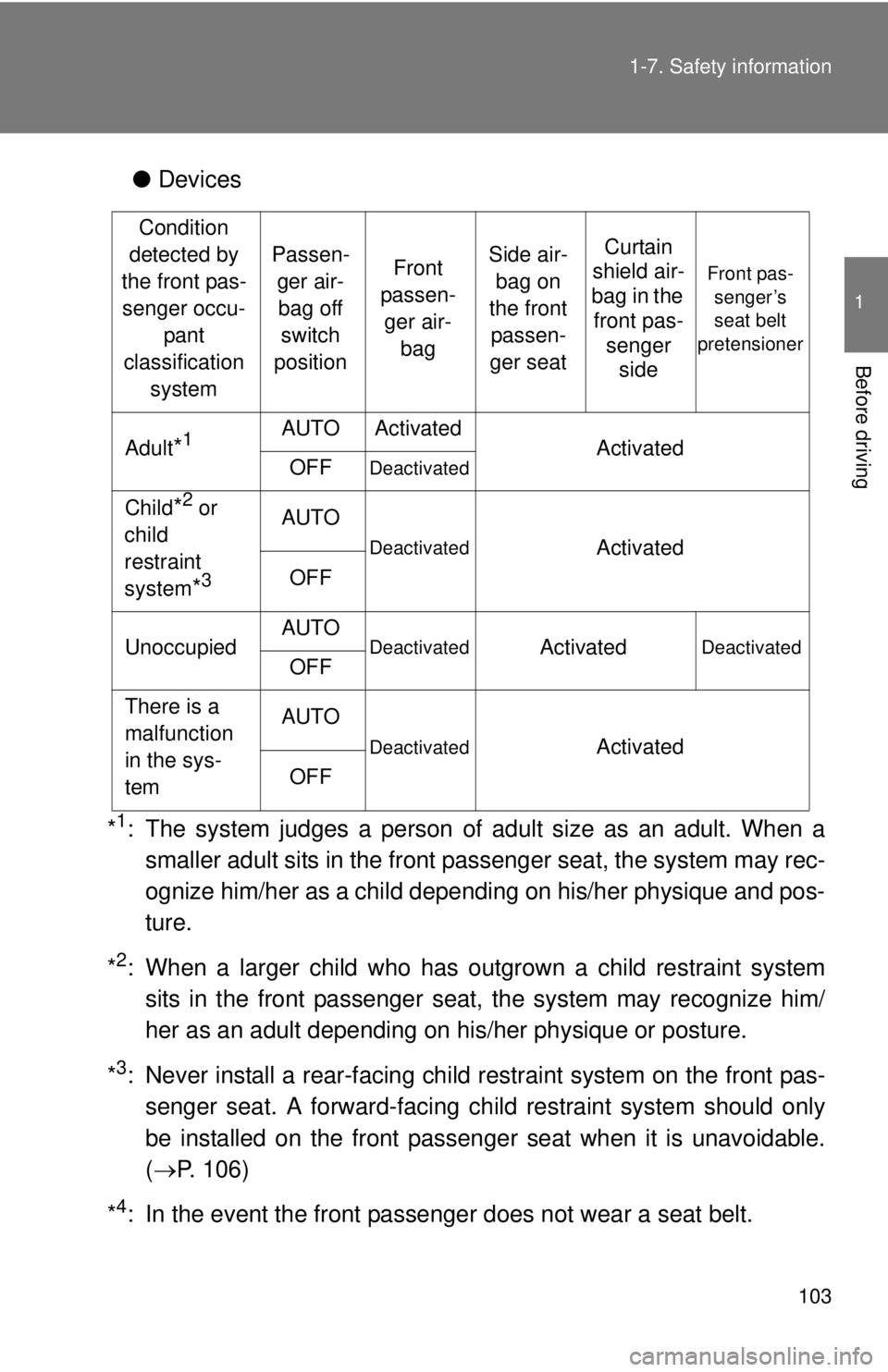
103
1-7. Safety information
1
Before driving
●
Devices
*
1: The system judges a person of adult size as an adult. When a smaller adult sits in the front passenger seat, the system may rec-
ognize him/her as a child depending on his/her physique and pos-
ture.
*
2: When a larger child who has outgrown a child restraint system sits in the front passenger seat, the system may recognize him/
her as an adult depending on his/her physique or posture.
*
3: Never install a rear-facing child restraint system on the front pas-
senger seat. A forward-facing ch ild restraint system should only
be installed on the front passenger seat when it is unavoidable.
( P. 106)
*
4: In the event the front passenger does not wear a seat belt.
Condition
detected by
the front pas- senger occu- pant
classification system
Passen-ger air-bag off switch
positionFront
passen- ger air- bagSide air-bag on
the front passen-
ger seatCurtain
shield air-
bag in the
front pas- senger side
Front pas-
senger’s seat belt
pretensioner
Adult*1AUTOActivatedActivatedOFFDeactivated
Child*2 or
child
restraint
system
*3
AUTO
DeactivatedActivated
OFF
UnoccupiedAUTODeactivatedActivatedDeactivatedOFF
There is a
malfunction
in the sys-
temAUTO
DeactivatedActivated
OFF
Page 104 of 548
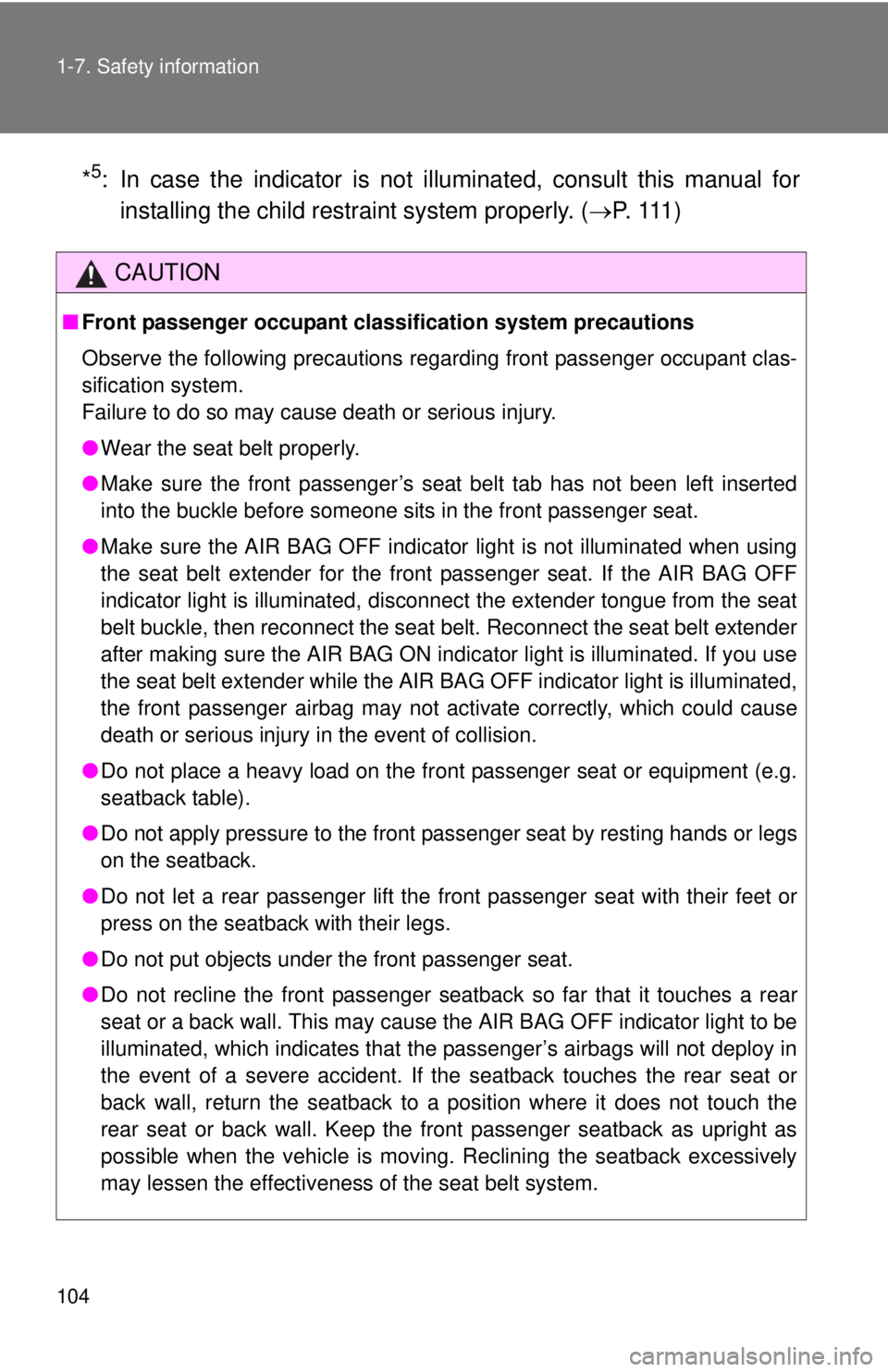
104 1-7. Safety information
*5: In case the indicator is not illuminated, consult this manual for
installing the child restraint system properly. ( P. 111 )
CAUTION
■Front passenger occupant cl assification system precautions
Observe the following precautions regarding front passenger occupant clas-
sification system.
Failure to do so may cause death or serious injury.
● Wear the seat belt properly.
● Make sure the front passenger’s seat belt tab has not been left inserted
into the buckle before someone sits in the front passenger seat.
● Make sure the AIR BAG OFF indicator light is not illuminated when using
the seat belt extender for the front passenger seat. If the AIR BAG OFF
indicator light is illuminated, disconnect the extender tongue from the seat
belt buckle, then reconnect the seat belt. Reconnect the seat belt extender
after making sure the AIR BAG ON indicator light is illuminated. If you use
the seat belt extender while the AIR BAG OFF indicator light is illuminated,
the front passenger airbag may not activate correctly, which could cause
death or serious injury in the event of collision.
● Do not place a heavy load on the front passenger seat or equipment (e.g.
seatback table).
● Do not apply pressure to the front passenger seat by resting hands or legs
on the seatback.
● Do not let a rear passenger lift the front passenger seat with their feet or
press on the seatback with their legs.
● Do not put objects under the front passenger seat.
● Do not recline the front passenger seatback so far that it touches a rear
seat or a back wall. This may cause the AIR BAG OFF indicator light to be
illuminated, which indicates that the passenger’s airbags will not deploy in
the event of a severe accident. If the seatback touches the rear seat or
back wall, return the seatback to a position where it does not touch the
rear seat or back wall. Keep the front passenger seatback as upright as
possible when the vehicle is moving. Reclining the seatback excessively
may lessen the effectiveness of the seat belt system.
Page 105 of 548
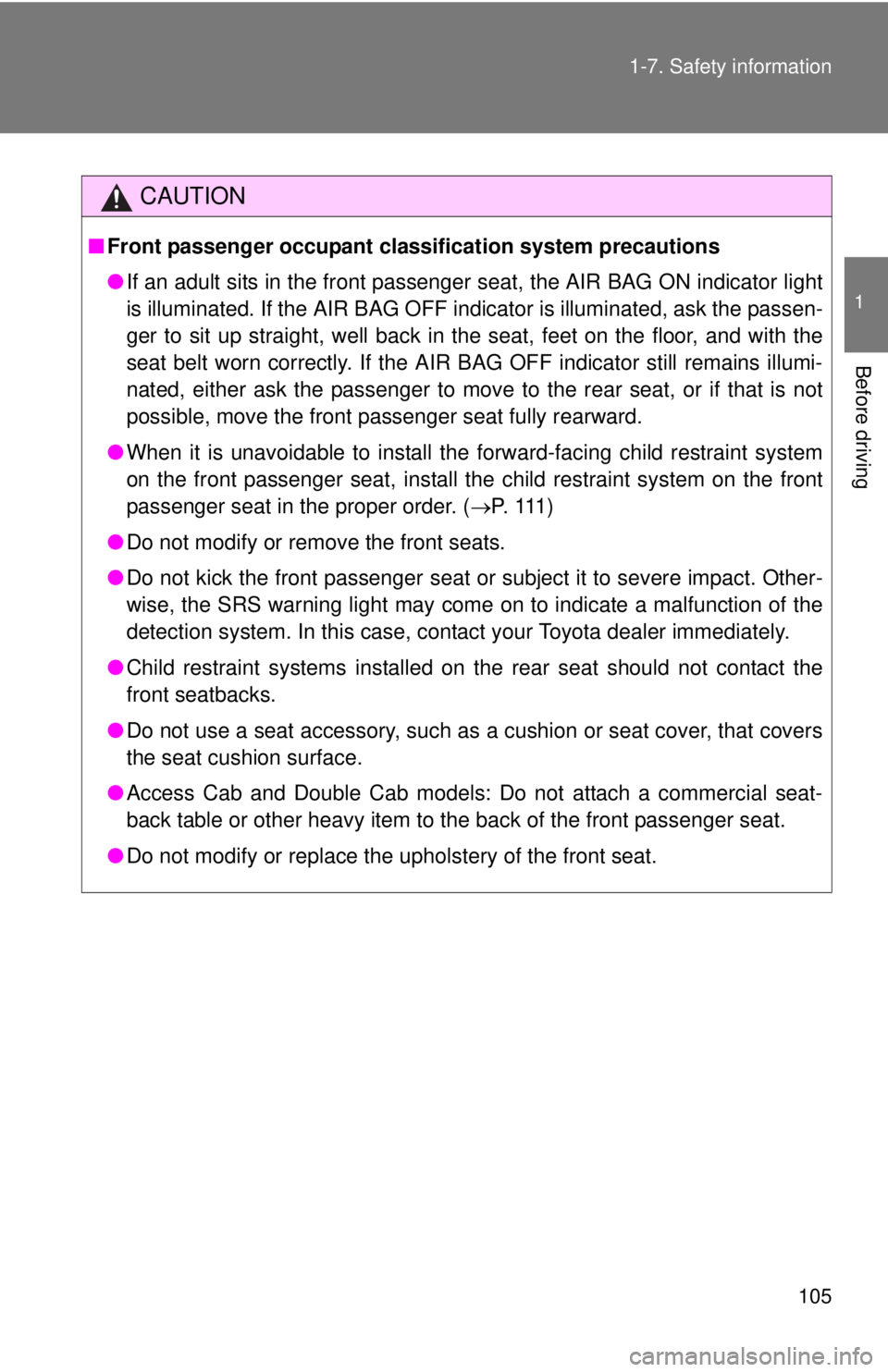
105
1-7. Safety information
1
Before driving
CAUTION
■
Front passenger occupant cl assification system precautions
● If an adult sits in the front passenger seat, the AIR BAG ON indicator light
is illuminated. If the AIR BAG OFF indicator is illuminated, ask the passen-
ger to sit up straight, well back in the seat, feet on the floor, and with the
seat belt worn correctly. If the AIR BAG OFF indicator still remains illumi-
nated, either ask the passenger to move to the rear seat, or if that is not
possible, move the front passenger seat fully rearward.
● When it is unavoidable to install the forward-facing child restraint system
on the front passenger seat, install the child restraint system on the front
passenger seat in the proper order. ( P. 1 1 1 )
● Do not modify or remove the front seats.
● Do not kick the front passenger seat or subject it to severe impact. Other-
wise, the SRS warning light may come on to indicate a malfunction of the
detection system. In this case, contact your Toyota dealer immediately.
● Child restraint systems installed on the rear seat should not contact the
front seatbacks.
● Do not use a seat accessory, such as a cushion or seat cover, that covers
the seat cushion surface.
● Access Cab and Double Cab models: Do not attach a commercial seat-
back table or other heavy item to the back of the front passenger seat.
● Do not modify or replace the upholstery of the front seat.
Page 106 of 548
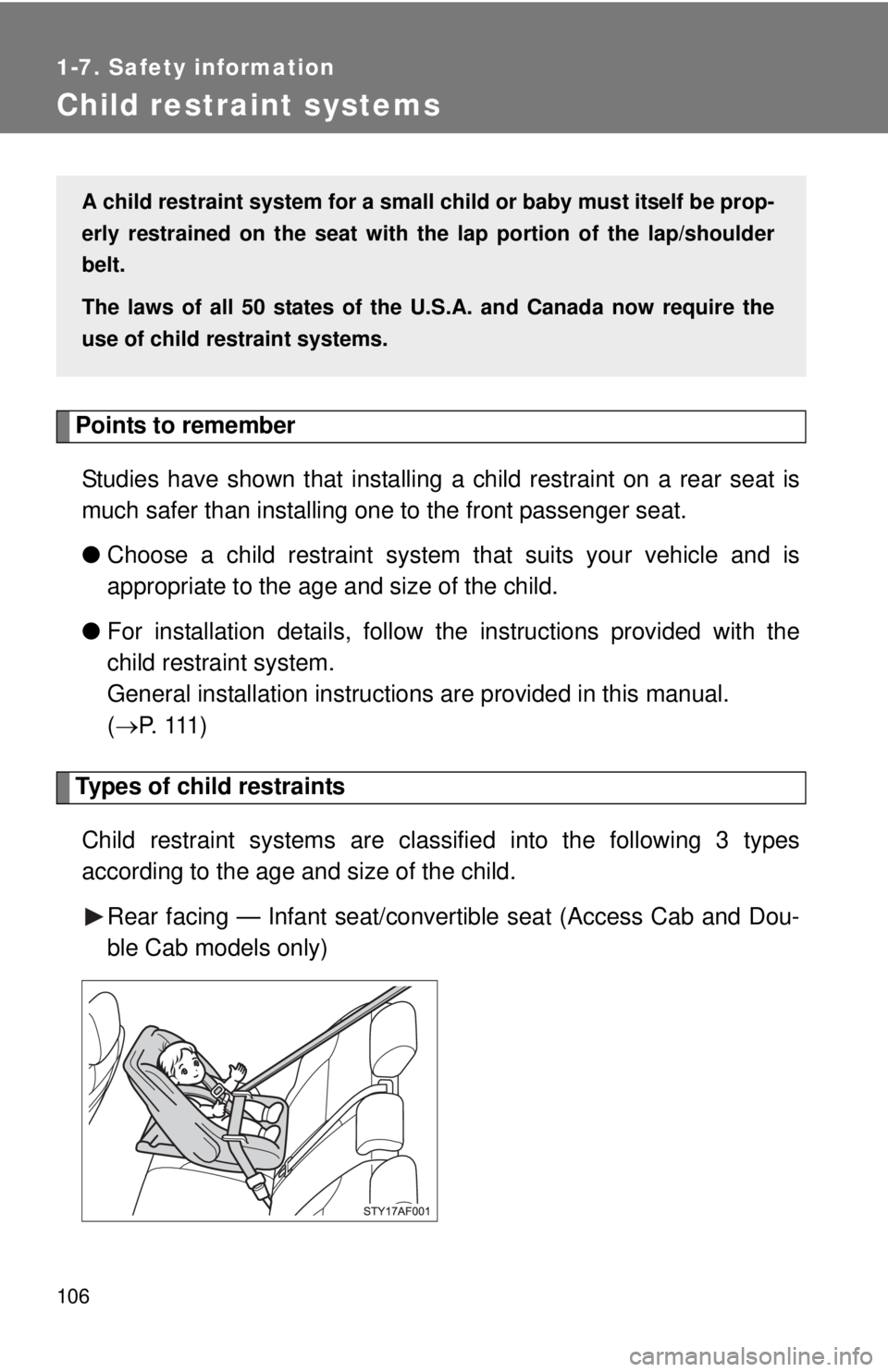
106
1-7. Safety information
Child restraint systems
Points to rememberStudies have shown that installing a child restraint on a rear seat is
much safer than installing one to the front passenger seat.
● Choose a child restraint system th at suits your vehicle and is
appropriate to the age and size of the child.
● For installation details, follow the instructions provided with the
child restraint system.
General installation instructions are provided in this manual.
( P. 1 1 1 )
Types of child restraints
Child restraint systems are clas sified into the following 3 types
according to the age and size of the child.
Rear facing — Infant seat/conve rtible seat (Access Cab and Dou-
ble Cab models only)
A child restraint system for a small ch ild or baby must itself be prop-
erly restrained on the seat with the lap portion of the lap/shoulder
belt.
The laws of all 50 states of the U.S.A. and Canada now require the
use of child restraint systems.
Page 107 of 548
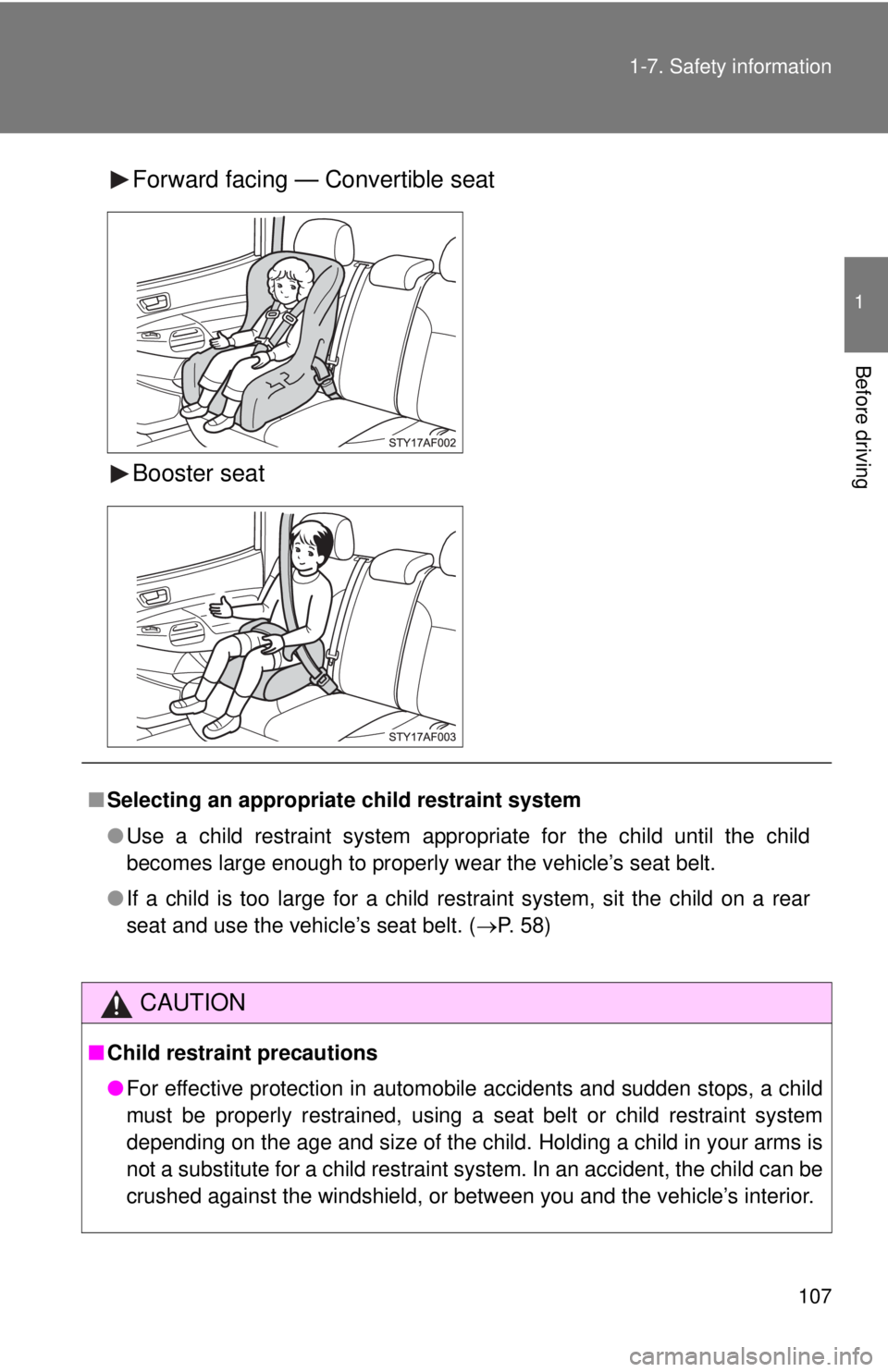
107
1-7. Safety information
1
Before driving
Forward facing — Convertible seat
Booster seat
■
Selecting an appropriat e child restraint system
● Use a child restraint system appropriate for the child until the child
becomes large enough to properly wear the vehicle’s seat belt.
● If a child is too large for a child restraint system, sit the child on a rear
seat and use the vehicle’s seat belt. ( P. 58)
CAUTION
■Child restraint precautions
●For effective protection in automobile accidents and sudden stops, a child
must be properly restrained, using a seat belt or child restraint system
depending on the age and size of the child. Holding a child in your arms is
not a substitute for a child restraint system. In an accident, the child can be
crushed against the windshield, or between you and the vehicle’s interior.
Page 108 of 548
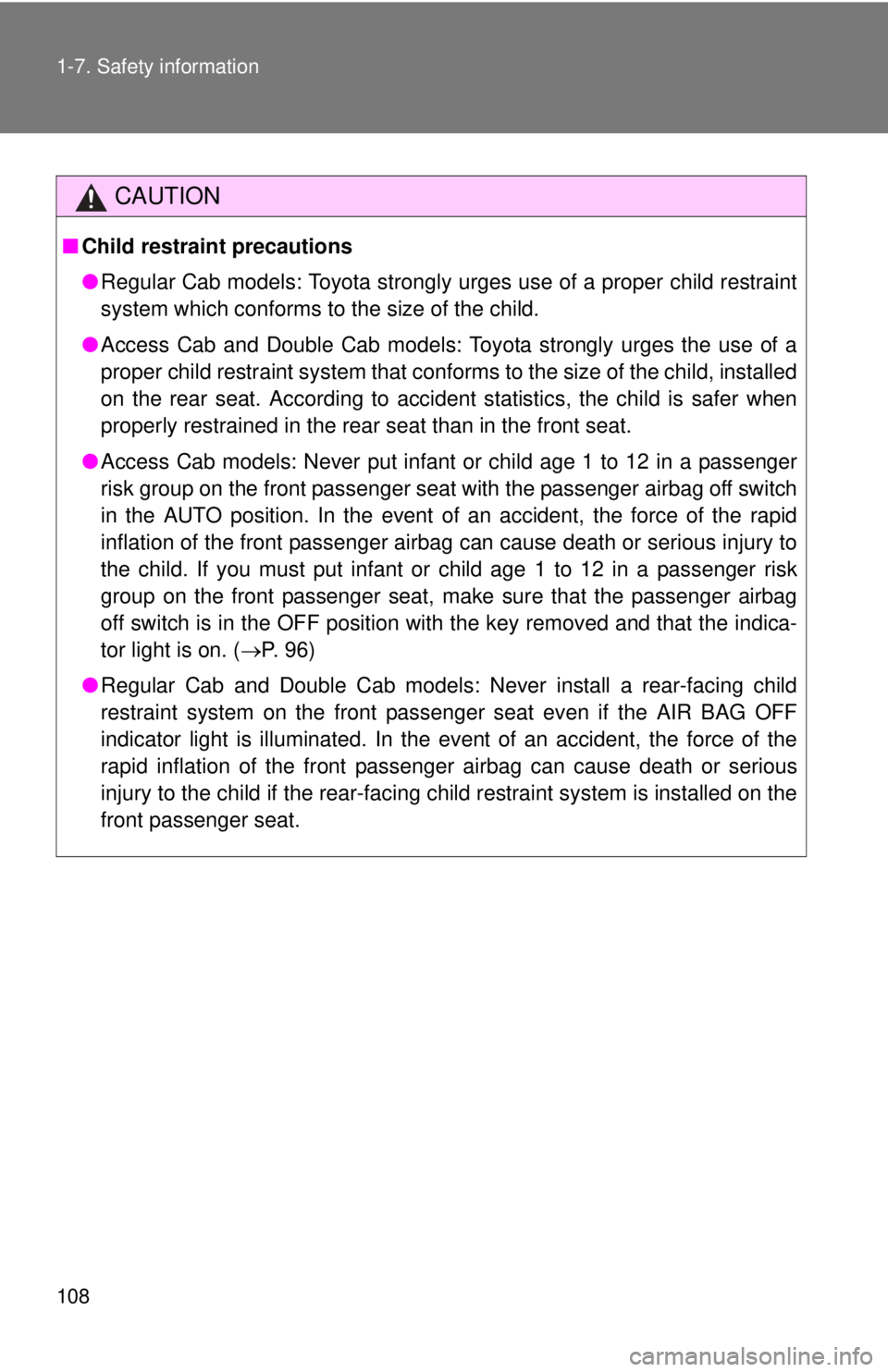
108 1-7. Safety information
CAUTION
■Child restraint precautions
●Regular Cab models: Toyota strongly urges use of a proper child restraint
system which conforms to the size of the child.
● Access Cab and Double Cab models: Toyota strongly urges the use of a
proper child restraint system that conforms to the size of the child, installed
on the rear seat. According to accident statistics, the child is safer when
properly restrained in the rear seat than in the front seat.
● Access Cab models: Never put infant or child age 1 to 12 in a passenger
risk group on the front passenger seat with the passenger airbag off switch
in the AUTO position. In the event of an accident, the force of the rapid
inflation of the front passenger airbag can cause death or serious injury to
the child. If you must put infant or child age 1 to 12 in a passenger risk
group on the front passenger seat, make sure that the passenger airbag
off switch is in the OFF position with the key removed and that the indica-
tor light is on. ( P. 96)
● Regular Cab and Double Cab models: Never install a rear-facing child
restraint system on the front passenger seat even if the AIR BAG OFF
indicator light is illuminated. In the event of an accident, the force of the
rapid inflation of the front passenger airbag can cause death or serious
injury to the child if the rear-facing child restraint system is installed on the
front passenger seat.
Page 109 of 548
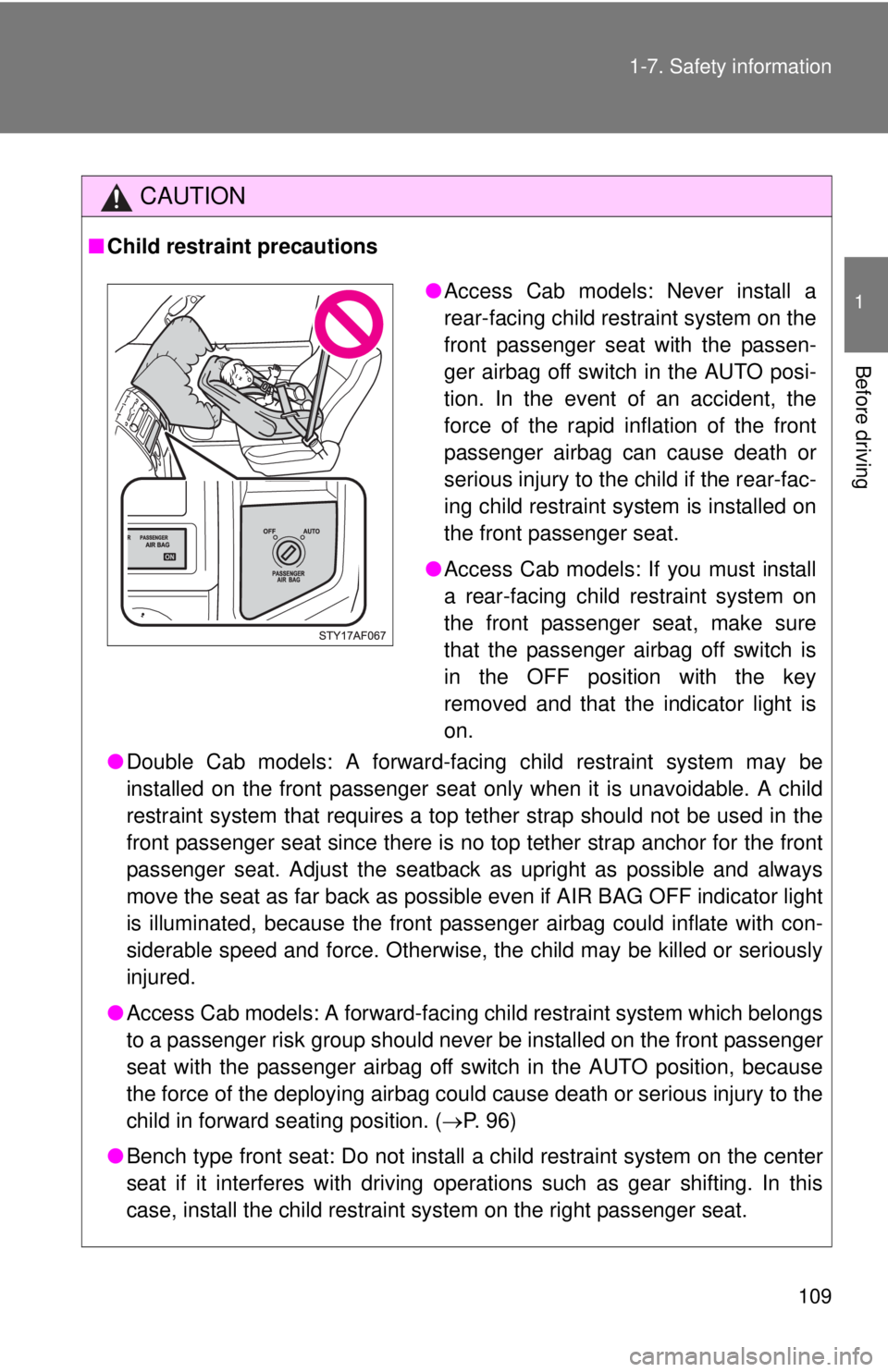
109
1-7. Safety information
1
Before driving
CAUTION
■
Child restraint precautions
●Double Cab models: A forward-facing child restraint system may be
installed on the front passenger seat only when it is unavoidable. A child
restraint system that requires a top tether strap should not be used in the
front passenger seat since there is no top tether strap anchor for the front
passenger seat. Adjust the seatback as upright as possible and always
move the seat as far back as possible even if AIR BAG OFF indicator light
is illuminated, because the front passenger airbag could inflate with con-
siderable speed and force. Otherwise, the child may be killed or seriously
injured.
● Access Cab models: A forward-facing child restraint system which belongs
to a passenger risk group should never be installed on the front passenger
seat with the passenger airbag off switch in the AUTO position, because
the force of the deploying airbag could cause death or serious injury to the
child in forward seating position. (P. 96)
● Bench type front seat: Do not install a child restraint system on the center
seat if it interferes with driving operations such as gear shifting. In this
case, install the child restraint system on the right passenger seat.
●Access Cab models: Never install a
rear-facing child restraint system on the
front passenger seat with the passen-
ger airbag off switch in the AUTO posi-
tion. In the event of an accident, the
force of the rapid inflation of the front
passenger airbag can cause death or
serious injury to the child if the rear-fac-
ing child restraint system is installed on
the front passenger seat.
● Access Cab models: If you must install
a rear-facing child restraint system on
the front passenger seat, make sure
that the passenger airbag off switch is
in the OFF position with the key
removed and that the indicator light is
on.
Page 110 of 548
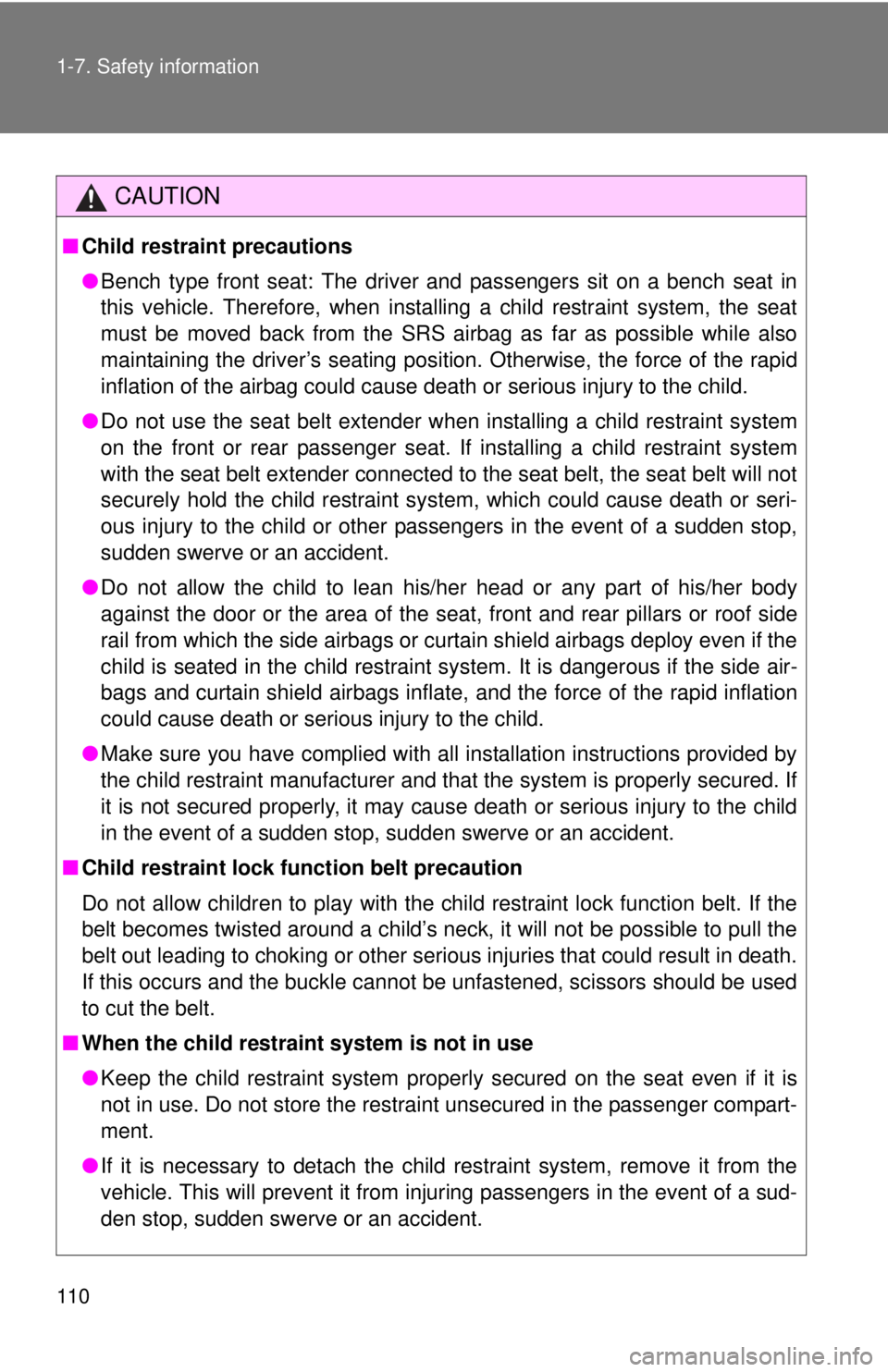
110 1-7. Safety information
CAUTION
■Child restraint precautions
●Bench type front seat: The driver and passengers sit on a bench seat in
this vehicle. Therefore, when installing a child restraint system, the seat
must be moved back from the SRS airbag as far as possible while also
maintaining the driver’s seating position. Otherwise, the force of the rapid
inflation of the airbag could cause death or serious injury to the child.
● Do not use the seat belt extender when installing a child restraint system
on the front or rear passenger seat. If installing a child restraint system
with the seat belt extender connected to the seat belt, the seat belt will not
securely hold the child restraint system, which could cause death or seri-
ous injury to the child or other passengers in the event of a sudden stop,
sudden swerve or an accident.
● Do not allow the child to lean his/her head or any part of his/her body
against the door or the area of the sea t, front and rear pillars or roof side
rail from which the side airbags or curtain shield airbags deploy even if the
child is seated in the child restraint system. It is dangerous if the side air-
bags and curtain shield airbags inflate, and the force of the rapid inflation
could cause death or serious injury to the child.
● Make sure you have complied with all installation instructions provided by
the child restraint manufacturer and that the system is properly secured. If
it is not secured properly, it may cause death or serious injury to the child
in the event of a sudden stop, sudden swerve or an accident.
■ Child restraint lock function belt precaution
Do not allow children to play with the child restraint lock function belt. If the
belt becomes twisted around a child’s neck, it will not be possible to pull the
belt out leading to choking or other serious injuries that could result in death.
If this occurs and the buckle cannot be unfastened, scissors should be used
to cut the belt.
■ When the child restrain t system is not in use
● Keep the child restraint system properly secured on the seat even if it is
not in use. Do not store the restraint unsecured in the passenger compart-
ment.
● If it is necessary to detach the child restraint system, remove it from the
vehicle. This will prevent it from injuring passengers in the event of a sud-
den stop, sudden swerve or an accident.